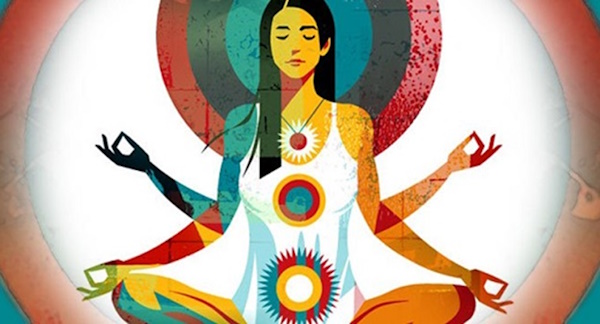by Cassie Shortsleeve: Finding Your Favorite Meditation Practice…

At times, meditation seems like a practice for someone else. While the benefits are clear — research has shown that monks who meditate for thousands of hours alter the structure of their brains and significantly decrease emotionally reactive behavior — it’s easy to think: “How nice for them, but who has that kind of time?”
Well, arguably, all of us need to. Last year Harvard research found that even those who had never meditated a day in their life saw benefits in five different regions of the brain from just 30 minutes of practice per day, over the course of eight weeks. And the payoffs are huge, meditation has been shown to relieve pain, lower levels of stress and anxiety, and boost brainpower.
Bringing some calm to your day doesn’t need to feel foreign, or far-fetched, or involve awakening your chakras. Dzogchen Ponlop Rinpoche, a leading Buddhist teacher, and author of the new book Emotional Rescue, explains that the Tibetan word for meditation literally means ‘familiarization’:
Meditation is really just getting to know your own mind.
Meditate Anywhere, Anytime
Practising mindfulness can take place anywhere as well: during a work commute, while eating dinner, or in a more structured setting. Randi Ragan, a holistic wellbeing expert and author of the recently published book A Year of Living Mindfully, explains:
Just like exercising a muscle, the more you practise the better you get at it: the easier you can shift into a present state of mind, and the bigger the results.
There are many different types of meditation — thousands by some counts — taught and practised around the world. There are probably as many teachers, each tending to favor one style. But no matter how you go about it, the goal – and the results – are the same: peace of mind and wellbeing, greater focus and creativity, and better relationships. According to Ragan:
You just have to figure out which type resonates with your personality.
Mindfulness can be practiced anywhere and the more you practice, the better you get.
Maybe you think you’d like to drop into a studio or class environment to find your zen. Or you know you’d rather carve out some time alone, seated and still. Or perhaps you prefer sound over silence. There are many approaches and styles of meditation. Try them out and then pick the one that helps you breathe a little more calmness into your life…your ownway.
1. Mindfulness
Mindfulness is the most overused word in wellness circles. It is also the most well-studied, widely practiced Western style of meditation. In this type of practice you learn to train your mind by focusing your attention on your breath, or on sensations in your body. It’s a form of meditation designed to develop the skill of paying attention to our inner and outer experiences with acceptance, patience, and compassion.
Part of the medical school’s psychiatry department at the University of California Center for Mindfulness, describes mindfulness as a quality that most people don’t know can be cultivated:
Mindfulness is about paying attention on purpose, deeply and without judgment, to whatever arises in the present moment, either inside or outside of us.
Mindfulness teaches you how to train your mind by focusing on your breath.
By intentionally practicing mindfulness, deliberately paying more careful moment-to-moment attention, we can live more fully and less on automatic pilot, thus, being more present for our own lives. And more comfortable in our own skin.
How to Do It
In most practices, you sit comfortably, close your eyes and focus your attention on the inhale and exhale of your breath. When thoughts pop up (to-do list! deadlines!) you acknowledge them, and then let them go; returning your attention to your breath. Rinpoche says that the goal of meditation is a quieting of the mind:
Sitting down with our mind and allowing it to relax from all of the busyness and all of our worries and anxieties, and just be in the present moment.
This type of meditation is great for increasing focus and relieving stress.
2. Loving-Kindness
In our world of Instagram filters and body shaming, who couldn’t use a little more love? According to Ragan, loving-kindness meditation is about surrounding yourself with thoughts of — well — love.
Loving-kindness meditation involves sending goodwill, kindness, and warmth to others.
Sharon Salzberg, a renowned meditation teacher, and speaker explained it further:
Throughout our lives we long to love ourselves more deeply and find a greater sense of connection with others. Our fear of intimacy — both with others and ourselves — creates feelings of pain and longing.
Loving-kindness meditation is a practice of care, concern, tenderness, and warmth for oneself and others.
How to Do It
One of the aims in this meditation is to feel good, so you start by sitting comfortably in a quiet place, and allow 15 to 20 minutes for practice. Begin to focus your attention on your chest area, or ‘heart center’. With your inhales and exhales, start to become aware of the sensations in that part of your body. You might think positive thoughts or phrases like, “May I be happy”.
According to international meditation teacher Jack Kornfield, this type of meditation may at times “feel mechanical or awkward” and actually bring up feelings that are the opposite of what you’re trying to cultivate. He advises being patient and kind towards yourself.
Once you’ve established a stronger sense of self-compassion, you can expand your practice to include others — people you know and love, strangers, and even the rest of the world. – Randi Ragan.
Research suggests that people who meditate this way report a decrease in self-criticismand release serious emotional tension — a potential trigger for health issues like migraines.
3. Mantra
According to Charlie Knoles, co-founder of The Path, which hosts weekly sits, courses, workshops, and social events, this ancient meditation technique usually involves a Sanskrit mantra, which you silently repeat to yourself for 20 minutes, twice a day. Or any sound or phrase that a teacher might suggest.
Mantra chanting is a powerful way to calm your mind and get into a meditative space.
The intention with this method is to allow the mind to become completely quiet and expansive. Mantra-based meditation includes Transcendental Meditation (TM), Siddha yoga, and other methods from the Vedantic tradition. TM first entered Western culture via the Beatles, and was initially associated with Nehru jackets, tofu, and world peace. After a spate of lawsuits and bad publicity in the 1980s, TM was dismissed as a hippie affectation and a fad but is now widely accepted as a medical process that has profound health benefits.
How to Do It
This type of meditation is great for helping to increase creativity and release stress. Many people who practice mantra meditation say it helps them transcend their present state and lose track of time. To meditate with mantras, you silently repeat words or a series of words (‘love’ or ‘I am at peace’ are two examples) that are meaningful to you. Regan explains that you work to focus your mind on this message by repeating the mantra in your head (or chanting it softly) over and over again.
The vibration of sounds is believed to alter the mind and relax the body as well as infuse it with specific energy.
4. Moving
If the thought of sitting crossed-legged and silent while you meditate sounds excruciating, don’t do it. Physical practices such as yoga, tai chi, and qigong – an ancient Chinese practice – all involve mindfulness, breath work, and movement.
Moving meditation incorporates mindfulness, breath work, and physical practice.
Moving meditation is an easy, accessible meditation method, since most people have already incorporated some type of exercise into their life. It also frees you from a more constricting practice, if that’s not your thing.
How to Do It
A good start is to sign up for a yoga or tai chi class. You can practice mindfulness through a simple downward dog or sun salutation in a yoga class, or even while walking. In any of these physical practices, you link breath to movement, which encourages a mind-body connection and focuses your attention on the present moment — the ultimate aim of all meditation.




